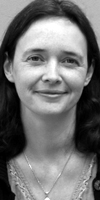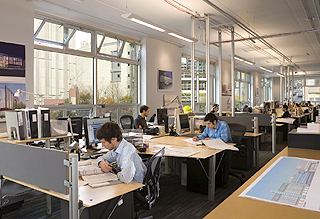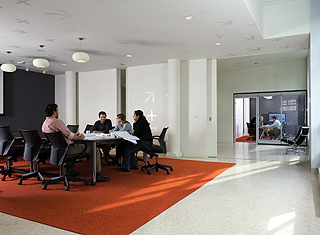
DJC.COM
February 22, 2007
A platinum LEED rating — how we did it
Perkins + Will

Sturgeon
|
As our region continues to embrace sustainable building, projects are continuing to reach higher levels of performance.
In October the Seattle office of Perkins + Will achieved the first LEED-Commercial Interiors platinum rating in Washington, the third project in the nation to achieve a LEED-CI platinum rating.
The U.S. Green Building Council’s LEED green-building rating system has four levels of certification: certified, silver, gold and platinum.
In Washington state there are two LEED-CI projects at the certified level and five at the silver level. Nationwide, only three out of the 92 LEED-CI projects are certified at the platinum level.

Photos courtesy of Perkins + Will Perkins + Will disconnected from its building’s HVAC system and replaced its fixed windows with operable ones. |
The U.S. Green Building Council, seeking to encourage more platinum-level projects, announced that any project that is certified at the platinum level this year will receive a refund on its certification fees.
At the announcement the council stated: “Platinum buildings are highly energy and resource efficient; provide superior indoor comfort for the building’s occupants; and dramatically reduce carbon dioxide emissions, a primary cause of global climate change.”
Is this financial incentive enough to make a difference?
Strong goals
For Perkins + Will the path to get to platinum had its challenges. So how did this project achieve platinum and what lessons can our community learn to make this achievement more commonplace?
The 12,000-square-foot project is on the second floor of the Galland Building on Second Avenue and University Street.
The project team was determined to achieve a platinum rating from the beginning.
“We are always encouraging our clients to build in a more sustainable way,” said Kay Kornovich, director of the Seattle office. “We were excited for the opportunity to demonstrate our commitment to sustainability in our own office.”
Starting the project with a strong set of sustainable goals and support from all stakeholders is crucial to obtaining a platinum rating.
A common issue that prevents tenant-improvement projects from obtaining a platinum rating is the limitations of the existing space and building. The Perkins + Will space was no different, full of enclosed offices around the perimeter, a low suspended ceiling, windows that did not open and an energy-intensive HVAC system. The likelihood of getting LEED platinum seemed slim.
Natural ventilation

Green projects that limit finish materials and open up space for natural air flow may have fewer sound-absorbing surfaces, making acoustics an issue in conference areas. |
While making a modernist statement with a simple design concept, the design team disconnected from the building’s HVAC system and replaced the fixed windows with operable windows. The suspended ceiling was removed to reveal 12-foot ceilings and the original heavy timber structure of the building.
Disconnecting from the building’s HVAC system enabled the project to achieve enough points to reach the platinum level. A new perimeter heating system was installed in the space.
Natural ventilation is an ideal strategy for the Northwest’s mild climate, as there are only a few weeks a year when the temperatures reach beyond the comfort limit of 78 degrees.
The project team added external shades to the west side of the space to reduce the heat gain and glare created by the hot afternoon sun in the summer. The replacement of the windows would not have been possible without the partnership of the building owner, Samis Land Co., which provided half of the funding for the building’s new windows, improved glazing and mechanical systems.
There were numerous other sustainable strategies incorporated into the design: The lighting is 46 percent more energy efficient than a typical space, 78 percent of the materials were sourced regionally, and all wood products were sourced from Forest Stewardship Council-certified sustainable forests.
The project also uses half of the energy that a typical space would, saves 40 percent of the water compared with a typical space and recycled 98 percent of the construction waste.
Living with the results
Many green projects have longer lead times, so making such a project work within the short and fast-paced construction schedule of a tenant-improvement project can be a challenge.
Acoustics can be an issue for green projects — once we minimize finish materials to reduce the amount of materials used in the project, expose the ceiling and open up the space to allow natural ventilation, there are fewer sound-absorbing surfaces. This can be an issue in conference and gathering spaces in particular.
It is important to follow through on the sustainable strategies after the space has been occupied, educating janitorial staff about how to clean waterless urinals as well as communicating with occupants about when to open and close windows.
The Perkins + Will space has metered its electricity use to allow analysis of how much energy the space is using compared with how much energy was predicted to be used.
The Puget Sound region constructs thousands of tenant-improvement projects each year, creating a great amount of waste as well as a great opportunity to build in a more sustainable way. Pushing your next LEED-CI project to achieve a platinum rating will make a big contribution towards reducing the causes of global climate change.
Amanda Sturgeon, AIA, LEED AP, is the sustainable design leader for the Seattle office of Perkins + Will.
Other Stories:
- How much energy are you really saving?
- Green office building goes back to the future
- Let technology play a role in your green building
- Will more cash now mean big savings later?
- Snowboarding can teach us how to be green
- Can buildings be free of fossil fuels by 2030?
- My house is greener than your house
Copyright ©2009 Seattle Daily Journal and DJC.COM.
Comments? Questions? Contact us.